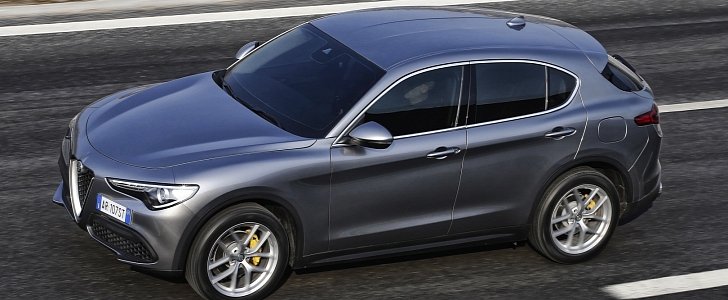The Stelvio went on sale early in 2017, but as it is often the case with new models, not all engine options were available in the first instance. But now, with the advent of an entry-level 2.0-liter inline-four turbo and a rear-wheel-driven 2.2-liter diesel, they are.
Let’s start with what is arguably the most controversial model of the lot. The only Stelvio offered with RWD, Alfa Romeo’s all-aluminum 2.2-liter diesel develops 180 PS (178 hp) and 450 Nm (332 lb-ft) of maximum torque from as low as 1,750 rpm. The Mutlijet II four-cylinder lump is by no means a slouch, but considering the €47,300 starting price, AWD would have been nice.
Available in Business, Super (€47,750), and Executive (€50,500) forms in select European markets, the least exciting Stelvio of them all comes as standard with a ZF-developed eight-speed automatic transmission. And so does the 2.0 Turbo Benzina 200 PS AT8 Q4 configuration, which is the least expensive Alfa Romeo Stelvio of the gasoline-powered category.
Churning out 200 PS (197 hp) and 330 Nm (243 lb-ft) at 1,750 rpm, the GME powerplant comes only with AWD. Nonetheless, the said motor is not that different from the no-frills diesel on paper: 7.2 compared to 7.6 seconds to 100 km/h (62 mph), 215 km/h (134 mph) top speed versus 210 km/h (130 mph). There’s a big difference in fuel consumption, though: 7.0 liters per 100 km on the combined cycle versus the diesel’s 4.7 liters per 100 km.
For whatever reason, the diesel comes as standard with a 58-liter fuel tank, whereas the gasoline-powered Stelvio boasts 64 liters. Fret not, motorway munchers, because the 2.2-liter turbo diesel offers a 64-liter tank as well, but only as long as you’re prepared to pay extra for it.
Other than the addition of two new engine options, the European-spec Stelvio crossover SUV also adds two additional contents. One of them is a chocolate-colored interior color, and the other is a sporty interior that's beautified by aluminum bits and pieces, black lining, leather on the steering wheel, and heated leather sports seats with front power bolster and driver memory.
Available in Business, Super (€47,750), and Executive (€50,500) forms in select European markets, the least exciting Stelvio of them all comes as standard with a ZF-developed eight-speed automatic transmission. And so does the 2.0 Turbo Benzina 200 PS AT8 Q4 configuration, which is the least expensive Alfa Romeo Stelvio of the gasoline-powered category.
Churning out 200 PS (197 hp) and 330 Nm (243 lb-ft) at 1,750 rpm, the GME powerplant comes only with AWD. Nonetheless, the said motor is not that different from the no-frills diesel on paper: 7.2 compared to 7.6 seconds to 100 km/h (62 mph), 215 km/h (134 mph) top speed versus 210 km/h (130 mph). There’s a big difference in fuel consumption, though: 7.0 liters per 100 km on the combined cycle versus the diesel’s 4.7 liters per 100 km.
For whatever reason, the diesel comes as standard with a 58-liter fuel tank, whereas the gasoline-powered Stelvio boasts 64 liters. Fret not, motorway munchers, because the 2.2-liter turbo diesel offers a 64-liter tank as well, but only as long as you’re prepared to pay extra for it.
Other than the addition of two new engine options, the European-spec Stelvio crossover SUV also adds two additional contents. One of them is a chocolate-colored interior color, and the other is a sporty interior that's beautified by aluminum bits and pieces, black lining, leather on the steering wheel, and heated leather sports seats with front power bolster and driver memory.















